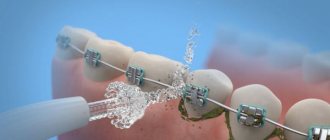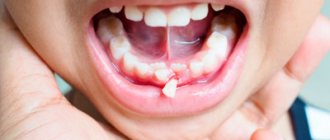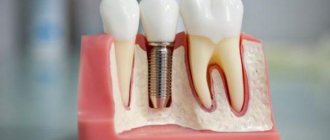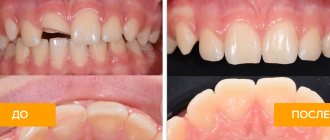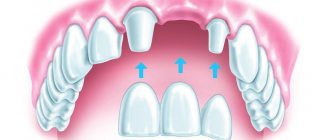Tooth enamel is the hardest tissue in the human body. Up to 90% of calcium reserves are concentrated here. However, cosmetic dentistry regularly deals with defects in this tissue. The fact is that hardness and ductility are different things. With impressive hardness levels, enamel is a fragile material that easily chips and cracks.
The situation gets worse if the enamel is weak. Temperature changes, chronic diseases, blows - and then the tooth breaks off. The situation is unpleasant, and in the long term it is also fraught with caries. Through the crack, bacteria penetrate directly into the tooth, to the pulp, which means that caries will quickly develop into pulpitis. In general, a chipped tooth is a reason to see a doctor, and quickly.
So, what to do if a tooth chips?
- Rinse your mouth with any suitable antiseptic or water to protect the tooth from bacteria and food debris.
- If there is bleeding, apply a tampon with hydrogen peroxide or a hemostatic sponge.
- Apply cold externally to prevent swelling from developing.
- If the pain is very severe, take a pain reliever.
- If a tooth chips on the street, try to rinse your mouth with drinking water (mineral water is also suitable, but not sugary drinks). Other measures can be postponed to your home or the nearest pharmacy.
After that, call your dentist. There is no point in going to emergency rooms - they will simply pull out the affected tooth, especially if a child’s baby tooth has chipped off. You need to eliminate the defect without unnecessary sacrifices.
Fortunately, there are ways to quickly restore a tooth, even if it is severely damaged. There is a whole direction - aesthetic restoration of teeth, it deals with both acquired and congenital defects. Today, restorative dentists work wonders to transform small and uneven teeth into a Hollywood smile. This direction is developed both in pediatric and adult dentistry.
Types of chipped teeth
Restoration methods depend on the damage. Dentists distinguish the following types of chipped teeth:
- Incomplete. A barely noticeable crack appears on the enamel, and the rest of the tooth is not affected. The easiest case, which requires purely aesthetic restoration.
- Enamel chip. If a small piece breaks off from a tooth, most likely only the enamel is damaged. If measures are taken quickly, the deep layers of the tooth will not have time to collapse either.
- Dentin chipping. This layer is located under the enamel, inferior to it in hardness, but reliably protects the nerve and pulp. If dentin is damaged, the tooth usually does not hurt; at most, it reacts to acids and cold.
- Chip exposing the pulp. If a tooth is severely cracked, its darker part is visible, and the person is in pain, this means that the pulp, the most sensitive part of the tooth, is damaged. This is where the nerve and blood vessels are located, so bleeding is common. If the pulp is chipped, you need to make an appointment with a doctor as soon as possible. However, when half a tooth chips off, people usually do not postpone the visit.
Restoration of injured central incisors in children
Injuries to the anterior teeth of the upper jaw are a common occurrence in children. There are several ways to treat this problem. The consequences of this type of injury can vary from a simple crack to complete avulsion of the tooth. It depends on the severity and nature of the injury. Causes of injury may include playground incidents, fights, or falls. In modern aesthetic dentistry, restorations of the anterior teeth cause the greatest difficulties.
There are several ways to treat and restore chipped front teeth. The choice depends on the dentist's point of view and his knowledge in the field of aesthetic dentistry. In recent years, significant progress has been made in the field of aesthetics and physical properties of composite materials.
Thanks to this, as well as improved techniques such as layering techniques, dentists are now able to imitate the natural appearance of the dentition with direct esthetic restorations. A wide range of enamel shades has also been created, giving dentists the ability to control the degree of translucency and opacity of these types of restorations during minimally invasive procedures. The preserved tooth fragment can be used for its restoration. In this case, a good aesthetic result is achieved.
Today, dentists can perform restorations and achieve aesthetic results using bonding techniques. If the crack is close to the pulp or the pulp is exposed, the dentist may perform endodontic treatment followed by the installation of a post and crown. You may opt for pulp capping with a crown, porcelain veneer, or direct composite restoration.
In children aged 7-8 years with mixed dentition, large pulp canals with open apices are often found. This is explained by the incompleteness of the development of the dentition. At this stage, the occlusal plane, as well as the position of the teeth and soft tissues, are unstable. They are at the stage of formation. Once completed, it is expected that ideal treatment can be carried out. Age is an important factor in choosing the optimal restoration method. If options exist, children should be treated conservatively until they reach an appropriate age.
Clinical case 1.
The patient, a 7-year-old boy, chipped one third of his incisor as a result of a fall (Figure 1). The father took the child to the family dentist. The treatment plan he proposed seemed overly aggressive to the man (as a child, he had a negative experience of dental treatment for a similar injury). Given his son's age, the man felt a more conservative approach was best. Father and son were referred to my clinic for consultation. The man provided one x-ray, as well as a chipped fragment of the 9th tooth in a plastic bag.
Photo 1. Photo before surgery
Photo 2. Smile before surgery, chipped 9th tooth.
Diagnostics.
Clinical examination and review of one periapical radiograph revealed no pulp exposure. A diastema was observed between teeth 8 and 9, with tooth 9 tilted towards the buccal surface. An examination of the bite revealed the absence of occlusal contacts between the anterior teeth of the upper and lower jaw. The final position of the teeth, bite plane and soft tissues have not yet formed. Therefore, treatment options have been limited to the most conservative, minimally invasive procedures. After examining and cleaning the fragment, it was installed in place. Checked compatibility. To stabilize the fragment while the bond formed, a mastic stent with vinyl polysiloxane was made (Photo 3).
Photo 3. Checking the compatibility of the fragment.
After taking scans and photographs, taking into account the age of the child, his father was offered the following treatment options:
* Restoration of a chipped tooth using a light-curing composite
* Making a ceramic veneer (at this age this method is not recommended due to the changing size of the tooth and the development of soft tissues)
* Reattachment of tooth fragment
Treatment plan.
Due to the absence of symptoms, treatment was started without anesthesia. The dentin of the tooth and the fragment was cleaned with pumice, washed and dried. The tooth and fragment were disinfected in a surgical scrub with 2% chlorhexidine gluconate for 60 seconds. They were then washed, placed in a 5% sodium hypochloride solution and washed again.
After this procedure, the surgical field was isolated with cotton swabs. To increase bond strength and minimize microleakage, a full etching technique was used. The dentin and enamel surfaces of the chip and tooth were etched separately for 15 seconds using Ultra-Etch (Ultradent; South Jordan, UT) 35% with phosphoric acid (Ultradent), rinsed, then dentin primer and adhesive (ClearFil SE Bond) were applied J. Morita; Irvine, California), thinned with a blower and light cured for 15 seconds. To stabilize the position of the fragment while the bond was being formed, a stent was placed on the lingual surface of the tooth. The liner and dual-cure composite activator (Insure, Cosmedent; Chicago, IL) were then mixed and a small amount applied to both surfaces. The fragment was put in place. Excess composite was removed using a brush. Photopolymerization was carried out for 30 seconds. The stent was carefully removed; the lingual surface was cured for 30 seconds; this was followed by facial and lingual curing for 60 seconds.
The effects of trauma to the front teeth can range from simple cracking to complete avulsion, depending on the severity and nature of the injury. To increase the bond strength and durability of these types of restorations in children, it is recommended to apply excess composite along the fracture line. In this case, as mentioned earlier, due to the lack of occlusal contact between the maxillary and mandibular anterior teeth, a layer of hybrid composite was applied a few millimeters above the fracture line towards the lingual edge of the incisor, followed by light curing. A thin layer of light-curing clear composite was applied to the facial fracture line (Figure 4).
Photo 4. The fragment after bonding.
Grinding and polishing.
To ensure natural anatomy and structure of the tooth, a transparent composite was applied to its facial surface. Natural gloss on the facial and lingual surfaces of the teeth was provided by polishing strips. Flexi Disks (Cosmedent) followed by composite polishing paste were used to polish the face surface. Ball-shaped finishing diamond burs (Brasseler; Savannah, GA) were used on the lingual surface to create the desired structure. Finishing discs (Cosmedent) were then used followed by the application of a composite polishing paste. Occlusion was checked using various jaw movements to correct unstable contacts. The result was extremely satisfactory for the patient and his parents. The patient was scheduled for a postoperative visit within a few weeks (Figure 5).
Photo 5. View after treatment.
Clinical case 2.
This 11-year-old boy came to the clinic with his mother for the restoration of one third of the 9th tooth (Photo 6). The cause of the injury was a fall in the shower. Unlike the first case, the fragment of tooth 9 was lost. The patient's mother's request was high-quality conservative restorative treatment to restore the teeth to their natural appearance. Thanks to the improvement of the composition of modern composite materials, clinicians have at their disposal a variety of shades that can be used to create aesthetic restorations.
Photo 6. Case 2, view before surgery, chipped tooth 9. The fragment is lost.
Photo 7. Case 2, view of the smile before surgery, chipped tooth 9.
Diagnostics.
Clinical examination revealed no signs or symptoms of TMJ syndrome or malocclusion. Radiographs and clinical examination revealed no pulp pathologies. A diastema with minimal restoration was observed between teeth 8 and 9. There were no signs of a fracture of the 8th tooth.
Treatment plan.
After a complete clinical examination, an alginate impression was made, from which a study model was made for a diagnostic wax-up. Due to the loss of the fragment, the patient was offered a composite restoration. Considering the boy’s age, restoring teeth with ceramic veneers was not the best option. The patient's parents approved the proposed treatment option.
Before restoration, the tooth was cleaned with pumice and disinfected with chlorhexidine. Then we selected shades of Renamel Microfil composite (Cosmedent) and a hybrid composite to restore enamel and dentin. For the initial preparation, a round-head diamond bur (Brasseler) was used with a 2-mm lingual reduction with a deep and long bevel of 2-3 mm along the borders of the facial and lingual surfaces. To increase adhesion strength and minimize microleakage, complete etching was performed. The labial and lingual surfaces were etched for 15 seconds with 37% phosphoric acid, followed by 10 seconds of rinsing and drying. Clearfil SE-BOND adhesive (Kurary America, New York, NY) was applied to the facial and lingual surfaces. The material was then air thinned and light cured according to the manufacturer's instructions. To restore the lost fragment, a three-increment technique (dentin-enamel-incisor [Cosmedent]) was used. Renamel hybrid composite shade B1 was used to restore the lingual wall. To cover the edge of the bevel, a thin layer of opaque material was applied, followed by light curing.
Photo 8. Restoration of chipped tooth 9 with a composite material with microfiller.
Microfilled composite shade B1 was applied to the entire surface of the composite and tooth. An IPC spatula (Cosmedent) was used to create a random bevel and groove for the incisal composite. Then light curing was carried out. The groove is moistened using the composite, and compaction is carried out to ensure incisal transparency. Next comes curing.
Grinding and polishing.
The surface texture and final shape and function of the restoration are achieved through careful grinding and polishing. In this case, discs, crowns and contacts were used separately. Final polishing was carried out using a composite polishing paste (Cosmedent). The finished restoration looked like a real tooth (Photo 9).
Photo 9. Enlarged view of the finished restoration.
Conclusion.
Provided that the fragment is preserved and its integrity, it is possible to bond a chipped front tooth of the upper jaw with excellent results. In a short time, the fragment can be disinfected and secured in place using a dual-cure composite (Case 1). In cases of chip loss where a significant portion of the tooth is intact, conservative restorative treatment with direct esthetic composite as described in Case 2 is possible and is usually an excellent option for young patients (Figures 10 and 11).
Photo 10. View after surgery.
Photo 11. View after surgery.
Author: Khalil S. Saghezhi, DDS
What to do if your front tooth chips
Dental defects are always unpleasant, but it’s especially annoying if they are visible. Dentists call visible teeth the “smile zone” and pay special attention to its condition. So, what to do if your front tooth chips? The doctor will suggest the following restoration methods:
- Surface enamel cracks are simply sanded down. You can also saturate the tissue with minerals to speed up recovery. The problem is solved in one visit.
- If the tooth is cracked down to the dentin, grinding is not enough. The crack can be repaired with special materials that resemble a filling. The color is selected to match the enamel. The material is applied layer by layer, illuminated with a special lamp and finally sanded to perfect smoothness.
- If half a tooth is chipped off, it can be restored with a filling or dentures. Are used:
- veneers - decorative overlays on the tooth surface;
- inlays are metal-ceramic structures that replace part of a tooth;
- Crowns are structures that replace the entire visible part of a tooth.
Aesthetic dentistry tries to preserve the surviving tissue as much as possible, since the choice of methods and materials is very wide. But when a tooth is almost completely destroyed, it may be easier to remove it and install a crown or implant.
Options for solving the problem
First aid for a damaged tooth should be provided at home. You should rinse your mouth with warm water or disinfectant lotion.
If there is swelling of the gums or pain, you need to apply a cold compress to your cheek (no more than 15-20 minutes).
You can relieve pain with anesthetic drugs from your home medicine cabinet. “Nurofen”, “Ketorol”, “Ketanov”, “Tempalgin” and others help. You can apply a bandage soaked in novocaine to the affected area. In case of acute pain, you should urgently consult a dentist, as it indicates exposure of nerve endings.
For recovery, the dentist may suggest the following techniques:
- artistic restoration – relevant for minor damage, it allows you to restore integrity and give the most natural look;
- dental onlays - for this purpose, lumineers and ceramic veneers are used, they are put on the tooth and hide visual defects, usually used to restore incisors;
- inlays – used for large chips and severe damage, made individually for each patient and placed on the damaged crown;
- prosthetics – used in case of severe damage, when restoration and other recovery options are impossible and removal is required; a crown is installed instead of the damaged tooth.
The main factor influencing the success of treatment and recovery is the promptness of contacting a dentist. This will avoid complications, prevent further damage and save the damaged tooth with a minimum of costs.
Baby tooth chipped off
Everyone knows that chipped permanent teeth need to be repaired as soon as possible. However, pediatric dentistry often deals with damage to primary teeth. Children who experience the world by taste are especially often affected: it is enough to pull a stone, a plastic toy into their mouth, or simply fall, and the enamel may not withstand it.
First aid for a child whose tooth has chipped is the same as for an adult:
- Calm down, console.
- Give water to rinse your mouth.
- If necessary, stop the bleeding with peroxide or a sponge.
- Apply cold to reduce swelling.
- If the baby complains of pain, give the usual painkiller.
- Call pediatric dentistry in Krasnoyarsk, explain the situation and make an appointment.
The child will be examined by a doctor and sent for an x-ray to find out whether the soft tissues of the tooth have been damaged. The easiest case is if there is a chip on a tooth that was loose even before the injury. In this case, it is simply removed. But if the tooth holds tightly, treatment is needed. Otherwise, bacteria will penetrate through the crack, and this not only threatens the destruction of the baby tooth, but can also lead to problems with permanent ones.
At Mira Dentistry, we know how to find an approach to children whose baby teeth have broken off, even very young ones. After all, choosing a treatment is not difficult; it is more difficult to get a frightened child to trust the doctor. Correction methods are generally the same as for adults: polishing, remineralization, restoration with a filling.
What complications can there be?
If the chip is minor and does not cause discomfort, this does not mean that you can ignore it. Damage will lead to further destruction of hard tissues, and then dentin and pulp will be at risk. If the neurovascular bundle is damaged, the child will inevitably experience severe piercing pain, and further treatment may require removal of the nerve.
In addition, the presence of injured elements in the oral cavity creates favorable conditions for the proliferation of bacteria and infection of tissues. In addition to serious dental problems, this can lead to the development of diseases of the liver and kidneys, digestive and cardiovascular systems.
Prevention of chipped teeth
The golden rule of medicine: prevention is easier than cure. Prevention of chipped teeth requires:
- Avoid mechanical damage. Those at risk include fans of seeds and hard nuts, as well as those who like to chew pens and pencils.
- Avoid temperature changes in food. Ice cream with coffee is delicious, but if you regularly treat yourself to a combination of hot and cold, you can end up with microcracks in your enamel and an unscheduled visit to the dentist.
- Teenagers and adults: use protective mouthguards when playing traumatic sports. We are talking about boxing and other types of wrestling, hockey, rugby, handball - all where there is a high risk of getting hit in the face and, consequently, a chipped tooth.
- Eat properly. Lack of calcium is the most obvious cause of weakened enamel.
- Monitor the health. Many chronic diseases affect the condition of teeth. With diabetes, gastrointestinal disorders, and endocrine problems, the risk of getting a chipped tooth increases.
And, of course, it is worth monitoring your oral hygiene and regularly visiting adult or pediatric dentistry in order to notice and treat problems with enamel in time.
How much does it cost to fix a chipped tooth?
It happens that people do not seek help because they think that dental restoration is very expensive. In fact, it is easier and cheaper to immediately “fix” a chipped tooth than to wait for bacteria to penetrate through the crack and have to treat pulpitis. Moreover, all our services are available in installments.
In Mira clinics, prices for correction of a chipped tooth start at 2,000 rubles. — this is how much it costs to restore the edges of the front teeth. The final cost of treatment depends on the volume. You can call the clinic and we will tell you how much it costs to fix a chipped tooth in your case. But it’s better, of course, to make an appointment for an inspection - only after assessing the damage can you give an exact price. “Mira” is your dentistry, Krasnoyarsk is not in vain turning to us!
Symptoms of cracked teeth
Even if the crack is located on the child’s front tooth, it is not always noticeable. The defect is visible when it is of significant depth and extent, as well as when it gradually stains. Only a dentist can notice the problem in the early stages.
In some cases, additional symptoms appear, the presence and severity of which depend on the depth and location of the defect:
- pain or discomfort at rest and/or when chewing food;
- increased sensitivity to hot, cold, sour, etc.;
- bad breath;
- local change in enamel color;
- inflammation of the gums in the area of the defect, their bleeding.
